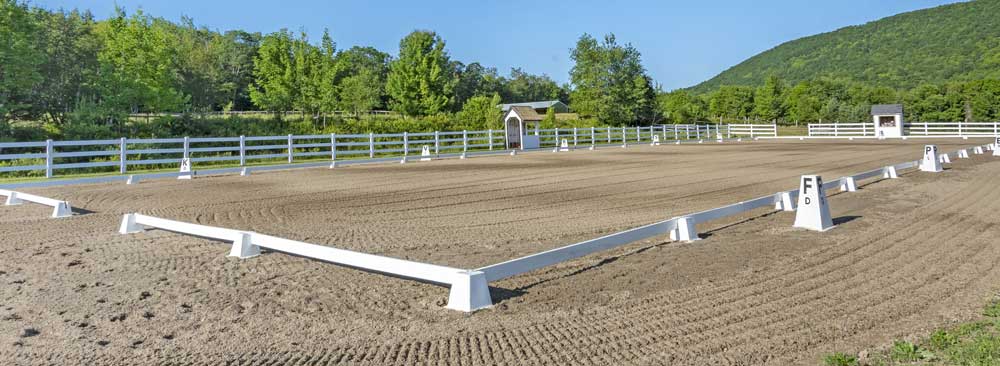
by Christina Keim & Premier Equestrian
Training within the limits of a properly sized standard arena is essential for success in competitive dressage, from the Young Horse divisions right through to Grand Prix. In particular, the arena’s precise geometry– demarcated by arena letters and quarter and center lines—helps riders to better coordinate transitions and movements, improve accuracy and create straightness in the horse. Ultimately, spending several training days per week practicing within the physical perimeter of a dressage ring offers a profound competitive advantage.
Leslie deGrandmaison is an FEI dressage competitor and coach, and USEF “r” dressage judge; when she sees a rider not attending to accuracy in their performance, it usually relates to the quality of their training. While judges are most concerned with the horse’s adherence to the training scale and demonstration of the essence of each movement in determining a score, accuracy also comes into play. Learning to correctly ride from letter to letter on the diagonal, to prepare for a straight centerline or to accurately ride a half circle or loop requires that a rider schools frequently in a proper arena.
“If you spend all your time practicing in an arena that is too wide, it makes the circles and other movements a bigger challenge for the horse,” says deGrandmaison. “If the arena is not wide enough, the horse is not accustomed to taking the lateral movements as far, or sustaining a lengthening or medium gait on the diagonal.”

The standard dressage arena is 20 meters wide by 60 meters long, and it is required equipment for the performance of First Level Test 1 and higher. The letters around the exterior start at the opening of the arena on the centerline and (moving clockwise) are A, K, V, E, S, H, C, M, R, B, P and F. Precise placement of the dressage arena letters results in a symmetrical set of ring markers that ensure the work completed on one rein matches that on the opposite side—and symmetry helps keep the training fair for each horse’s level of skill and strength.
“Knowing exactly where your twenty meter circle is on a three or four year old is important,” explains deGrandmaison. “You don’t want to start making your circles too small, which can cause stress and strain. Twenty, fifteen and ten meter circles are all very easy to ride fairly accurately if you have the right sized arena.”
The center line is an imaginary line bisecting the arena from A to C; the distance from center line to the rail is exactly half the width of the ring, ten meters. The arena is further divided by the quarter lines, which run lengthwise halfway between the center line and the rail. Riders can use each of these lines in combination with arena letters in unique ways to enhance their horse’s training.
“When you have a space that is defined, it is much easier to be creative about using it,” says deGrandmaison. “For example, a serpentine can use the whole arena, or be ridden between the center line and the track, or between the two quarter lines. You can do three, four, five or even six loops, depending on the horse’s level, and be sure each loop is of the same size. In an arena, you can confirm you are doing the movement properly without the horse feeling like you are just drilling the same thing.”
Finally, a series of imaginary dressage letters run up the center line; from the entrance and moving towards the judge, they are A, D, L X, I and G. The center line letters are positioned in a direct line with each pair on the perimeter, providing yet another guide for figure shape and size. As horses move up the levels, these center line letters become increasingly important for the correct execution of movements.

Competitive dressage riders will realize immediate benefits from practicing within the perimeter of a proper arena. Green horses desensitize to both the sight of the ring and the noise of footing kicking up against it, or even their leg coming into contact with it. The arena also enhances straightness in horses of all levels and helps riders to better use their corners. From the USEF Rulebook (DR 109), “Corners should be ridden as one-quarter of a volte appropriate to the level of the test (10 meters at Training-First Levels, 8 meters at Second-Fourth Levels and 6 meters above Fourth Level.)”
“Without an arena, there are people who, with experience, can learn how to ride proportionate to the space,” says deGrandmaison. “But the majority of us can’t, and having the actual correct arena allows you to experience all the little mistakes at home, so you can resolve them before competing.”

While purchasing a standard arena can represent a significant up-front investment, it will repay in training dividends. Dressage arenas that are properly cared for will last for years and retain their value.
“Having an arena is really important, especially for horses and riders that are just learning and coming up the levels,” says deGrandmaison.
For a free consultation, or to get started on your own dressage ring, contact Premier Equestrian today.
ALL CONTENT COPYRIGHT 2020 PREMIER EQUESTRIAN





